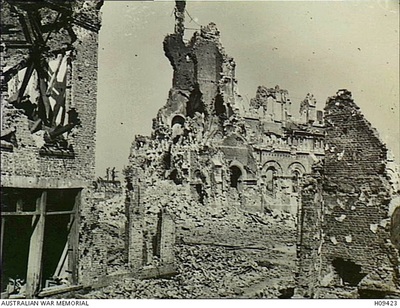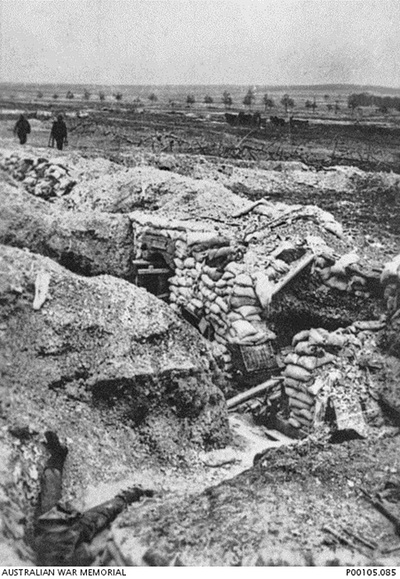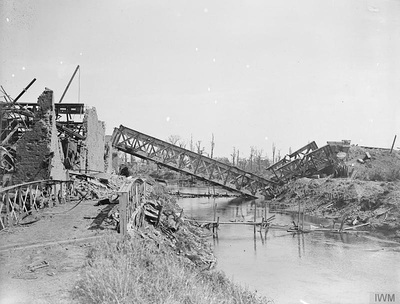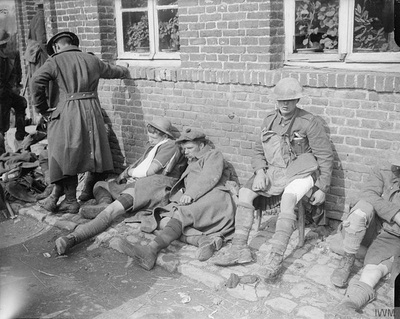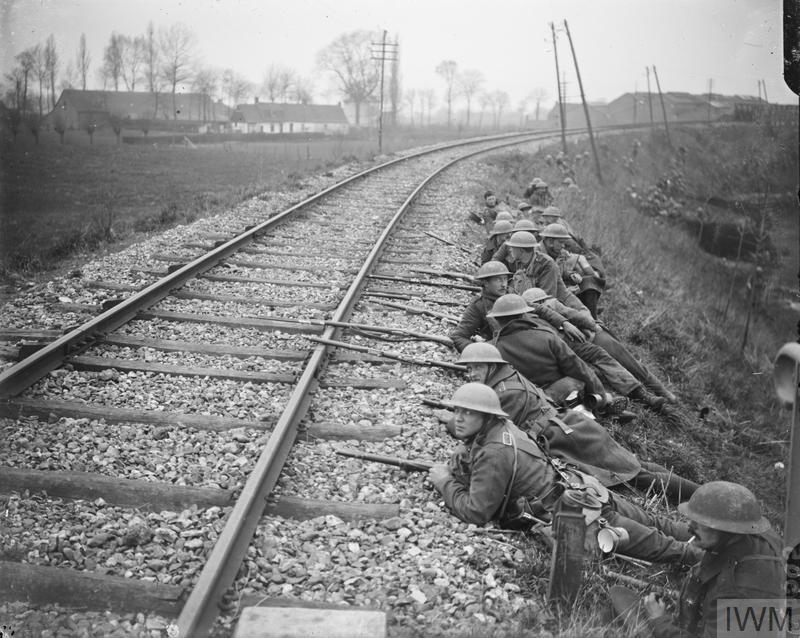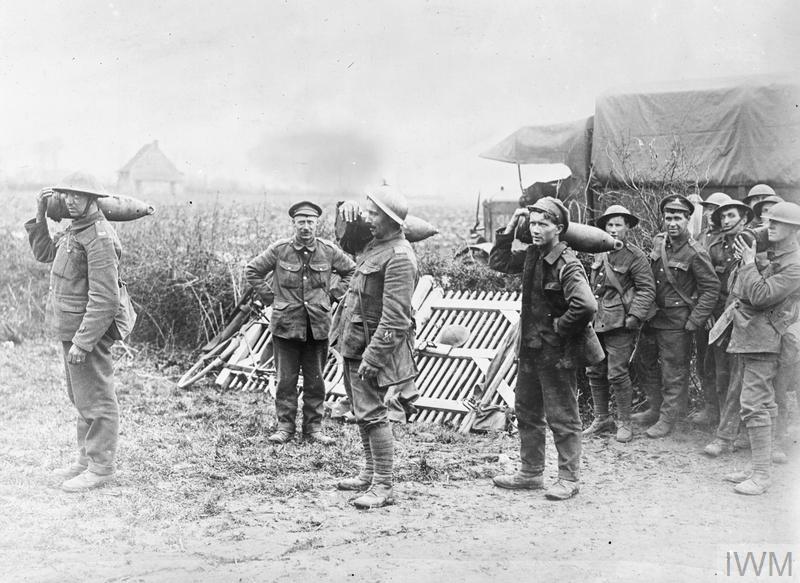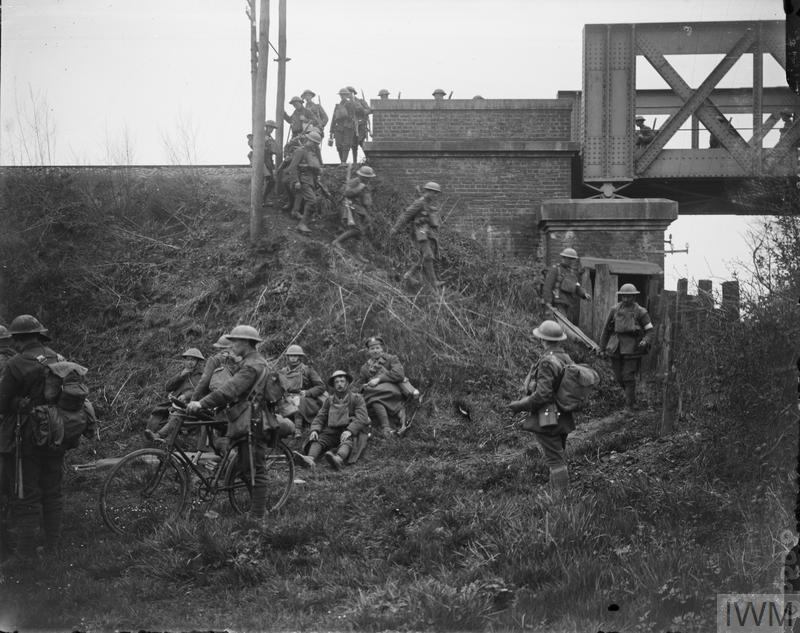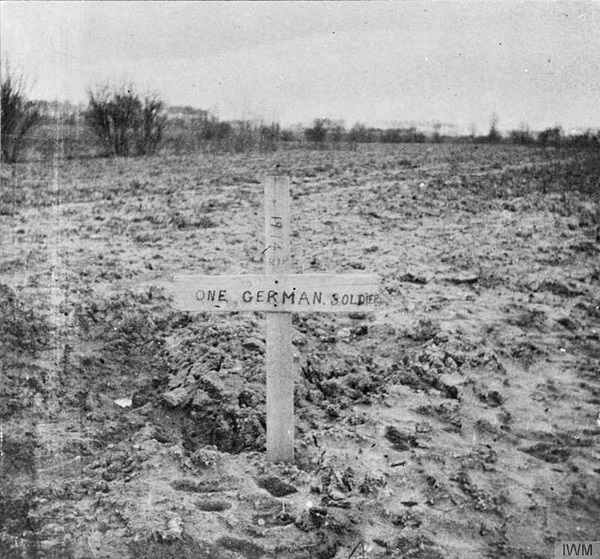MERVILLE COMMUNAL CEMETERY
Nord
France
GPS Coordinates: Latitude: 50.64553, Longitude: 2.63971
Location Information
Merville is a town 15 kilometres north of Bethune and about 20 kilometres south-west of Armentieres.
The Communal Cemetery is on the north-east side of the town to the north of the D38 road to Neuf-Berquin.
Visiting Information
OPENING TIMES:
April to October: 08.00 - 20.00
November to March: 08.00 - 17.30
Disabled access possible via the large door of the Communal Cemetery. Access to the cemetery extension is also via the large door of the Communal Cemetery as the service entrance of the Cemetery Extension is too small and there are steps.
Historical Information
Merville was the scene of fighting between the Germans and French and British cavalry early in October 1914 but from the 9th of that month to 11 April 1918, it remained in Allied hands. In October 1914, and in the autumn of 1915, the town was the headquarters of the Indian Corps. It was a railhead until May 1915, and a billeting and hospital centre from 1915-1918. The 6th and Lahore Casualty Clearing Stations were there from the autumn of 1914 to the autumn of 1915; the 7th from December 1914, to April 1917; the 54th (1st/2nd London) from August 1915 to March 1918, and the 51st (Highland) from May 1917 to April 1918.
On the evening of 11 April 1918, in the Battles of the Lys, the Germans forced their way into Merville and the town was not retaken until 19 August. The cemeteries were not used again until the concentration of battlefield burials into the Extension began, after the Armistice.
During the Second World War the river Lys was the southern end of a deep but narrow area held by British forces at the end of May 1940. Merville is on the territory over which were fought desperate rearguard actions during the withdrawal of the British Expeditionary Force to the coast, for evacuation from Dunkirk.
MERVILLE COMMUNAL CEMETERY was used by French troops (chiefly cavalry) in October 1914, and for Commonwealth burials from that date until August 1916 (in the case of officers, to March 1918). It now contains 1,268 Commonwealth burials of the First World War, and 12 French war graves. There is also 1 non war burial.
Total Burials: 1,290.
World War One Identified Commonwealth Burials: United Kingdom 1,133, India 97, Australia 21, Canada 11. Total 1,262.
World War One Other Nationalities: France 12, Germany 8. Total 20.
Non War Burial: 1.
MERVILLE COMMUNAL CEMETERY EXTENSION was opened in August 1916, and used by Commonwealth and Portuguese hospitals until April 1918. It was enlarged after the Armistice when graves were brought in from the battlefields immediately north and east of Merville and from the following cemetery:-
CAUDESCURE HALTE CEMETERY, MORBECQUE, which was close to the road and the light railway from Merville to Hazebrouck, and just within the Bois-Moyen. It was made by fighting units, and it contained the graves of 38 soldiers from the United Kingdom who fell in the period April-August, 1918.
The Extension now contains 920 Commonwealth burials of the First World War, 345 of them unidentified. The 92 Second World War burials (18 of them unidentified) occurred mostly during the fighting in May 1940 and are interspersed among the First World War graves. The Extension also contains 19 war graves of other nationalities.
Total Burials: 1,032.
World War One Identified Commonwealth Burials: United Kingdom 569, Canada 3, South Africa 2, Australia 1. Total 575.
World War One Unidentified Burials Commonwealth Burials: 345.
World War One Other Nationalities: 19.
World War Two Identified Burials: United Kingdom 72, Canada 2, Germany 1, Poland 1. Total 75.
World War Two Unidentified Burials: 18.
The Extension was designed by Sir Herbert Baker and Noel Ackroyd Rew
Dedications
5817 Lance Corporal William J. Finnes, 2nd Bn. Royal Berkshire Regiment, 11th March 1915, aged 32.
Not known but found by his Grandson Keith Grover, now remembered.
25670 Mesech Rowlands, 17th Bn. Royal Welsh Fusiliers, died 20th January 1916, aged 17. Plot VI. G. 6.

173 Private
Harold Abell
9th Bn. Australian Infantry, A.I.F.
21st April 1916, aged 22.
Plot VI. P. 19.
Son of George and Mary Eliza Abell, of Granville St., Brisbane, Queensland. Native of Leicester, England.
His headstone bears the inscription "His Memory Will Live In Our Hearts Forever"
Studio portrait of 173 Private (Pte) Harold Harry Abell. Originally from Leicester, England, Pte Abell was a railway porter from Brisbane, Queensland prior to enlistment and embarked with A Company, 9th Battalion from Brisbane on HMAT Omrah on 24 September 1914. He was later wounded when his billets were shelled and he was evacuated to the 7th Casualty Clearing Station where, on 21 April 1916, he succumbed to his wounds and was buried in the Merville Community Cemetery, Dunkirk, France.
Harold Abell
9th Bn. Australian Infantry, A.I.F.
21st April 1916, aged 22.
Plot VI. P. 19.
Son of George and Mary Eliza Abell, of Granville St., Brisbane, Queensland. Native of Leicester, England.
His headstone bears the inscription "His Memory Will Live In Our Hearts Forever"
Studio portrait of 173 Private (Pte) Harold Harry Abell. Originally from Leicester, England, Pte Abell was a railway porter from Brisbane, Queensland prior to enlistment and embarked with A Company, 9th Battalion from Brisbane on HMAT Omrah on 24 September 1914. He was later wounded when his billets were shelled and he was evacuated to the 7th Casualty Clearing Station where, on 21 April 1916, he succumbed to his wounds and was buried in the Merville Community Cemetery, Dunkirk, France.
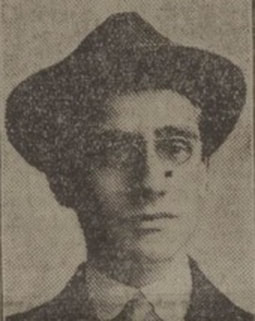
5018 Private
H. T. Dore
2nd/6th Bn. Gloucestershire Regiment
20th July 1916.
Plot XI. B. 35.
Son of Mr. H. W. Dore, of 16, Stanley Rd., Redland, Bristol.
H. T. Dore
2nd/6th Bn. Gloucestershire Regiment
20th July 1916.
Plot XI. B. 35.
Son of Mr. H. W. Dore, of 16, Stanley Rd., Redland, Bristol.
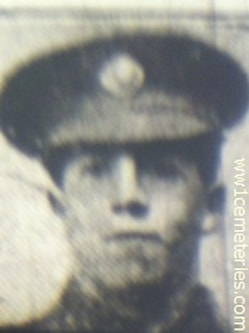
2793 Lance Corporal
Ernest Hambly
1st/5th Bn. Duke of Cornwall's Light Infantry
28th June 1916, aged 19.
Plot VI. P. 70.
Son of Mr. and Mrs. Leonard Hambly, of Helland, Bodmin, Cornwall.
Ernest Hambly
1st/5th Bn. Duke of Cornwall's Light Infantry
28th June 1916, aged 19.
Plot VI. P. 70.
Son of Mr. and Mrs. Leonard Hambly, of Helland, Bodmin, Cornwall.

3505 Lance Corporal
Francis Thomas Hooks
8th Bn. Australian Infantry, A.I.F.
17th May 1916, aged 25.
Plot VI. Q. 44.
Son of Walter and Eleanor Hooks, of 4, Rosedale Avenue, Glenhuntly, Victoria, Australia. Native of Caulfield, Victoria.
His headstone bears the inscription "Lord In Thy Keeping Leave We Our Dear Son Sleeping"
Francis Thomas Hooks
8th Bn. Australian Infantry, A.I.F.
17th May 1916, aged 25.
Plot VI. Q. 44.
Son of Walter and Eleanor Hooks, of 4, Rosedale Avenue, Glenhuntly, Victoria, Australia. Native of Caulfield, Victoria.
His headstone bears the inscription "Lord In Thy Keeping Leave We Our Dear Son Sleeping"

Lieutenant
James Gordon Keay
2nd/5th Bn. Royal Warwickshire Regiment
2nd July 1916, aged 20.
Plot VII. A. 20.
Son of Mr. and Mrs. E. C. Keay, of 28, Westfield Rd., Edgbaston, Birmingham.
His headstone bears the inscription; "Greater Love Hath No Man Than This That A Man Lay Down His Life To Save His Friends."
James Gordon Keay
2nd/5th Bn. Royal Warwickshire Regiment
2nd July 1916, aged 20.
Plot VII. A. 20.
Son of Mr. and Mrs. E. C. Keay, of 28, Westfield Rd., Edgbaston, Birmingham.
His headstone bears the inscription; "Greater Love Hath No Man Than This That A Man Lay Down His Life To Save His Friends."

1979 Private
Andrew Lassen
9th Bn. Australian Infantry, A.I.F.
22nd April 1916.
Plot VI. Q. 19.
Studio portrait of 1979 Private (Pte) Andrew Lassen, 9th Battalion, of Bogantungan, Queensland. Pte Lassen enlisted on 30 January 1915 and embarked from Brisbane on 16 April 1915 on board HMAT Kyarra. He died of wounds received in action on 22 April 1916 in France.
Andrew Lassen
9th Bn. Australian Infantry, A.I.F.
22nd April 1916.
Plot VI. Q. 19.
Studio portrait of 1979 Private (Pte) Andrew Lassen, 9th Battalion, of Bogantungan, Queensland. Pte Lassen enlisted on 30 January 1915 and embarked from Brisbane on 16 April 1915 on board HMAT Kyarra. He died of wounds received in action on 22 April 1916 in France.

4018 Private
Lindsay Ross
1st Australian Pioneers
15th May 1916, aged 23.
Plot VI. P. 43.
Son of Hugh and Helen Agnes Ross. Native of St. Germain's, Victoria, Australia.
His headstone bears the inscription "Until The Day Breaks And The Shadows Flee Away"
Studio portrait of 4018 Private (Pte) Lindsay Ross, 12th Battalion, of King Island, Tasmania. A labourer prior to enlistment, Pte Ross embarked for overseas service aboard RMS Orontes on 24 November 1915. Pte Ross transferred to 1st Australian Pioneer Battalion in March 1916. He died of wounds sustained at Fromelles, France, on 15 May 1916, aged 23 years.
Lindsay Ross
1st Australian Pioneers
15th May 1916, aged 23.
Plot VI. P. 43.
Son of Hugh and Helen Agnes Ross. Native of St. Germain's, Victoria, Australia.
His headstone bears the inscription "Until The Day Breaks And The Shadows Flee Away"
Studio portrait of 4018 Private (Pte) Lindsay Ross, 12th Battalion, of King Island, Tasmania. A labourer prior to enlistment, Pte Ross embarked for overseas service aboard RMS Orontes on 24 November 1915. Pte Ross transferred to 1st Australian Pioneer Battalion in March 1916. He died of wounds sustained at Fromelles, France, on 15 May 1916, aged 23 years.
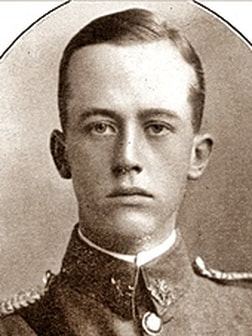
Lieutenant
Ronald Mortimer Slater
1st Bn. Worcestershire Regiment
21st November 1914, aged 23.
Plot I. K. 1.
Son of the late Major M. J. Slater (Royal Engineers) and Hilda Slater, of The Vicarage, Chudleigh Knighton, Devon.
Ronald Mortimer Slater
1st Bn. Worcestershire Regiment
21st November 1914, aged 23.
Plot I. K. 1.
Son of the late Major M. J. Slater (Royal Engineers) and Hilda Slater, of The Vicarage, Chudleigh Knighton, Devon.

Lieutenant
Joel Harrison Seaverns
1st Bn. London Regiment (Royal Fusiliers)
10th May 1915, aged 22.
Plot I. L. 4.
Son of Joel Herbert and Helen Gertrude Seaverns, of 25, Grosvenor Rd., London, S.W.I.
His headstone bears the inscription; "Ever Faithful."
Joel Harrison Seaverns
1st Bn. London Regiment (Royal Fusiliers)
10th May 1915, aged 22.
Plot I. L. 4.
Son of Joel Herbert and Helen Gertrude Seaverns, of 25, Grosvenor Rd., London, S.W.I.
His headstone bears the inscription; "Ever Faithful."

















